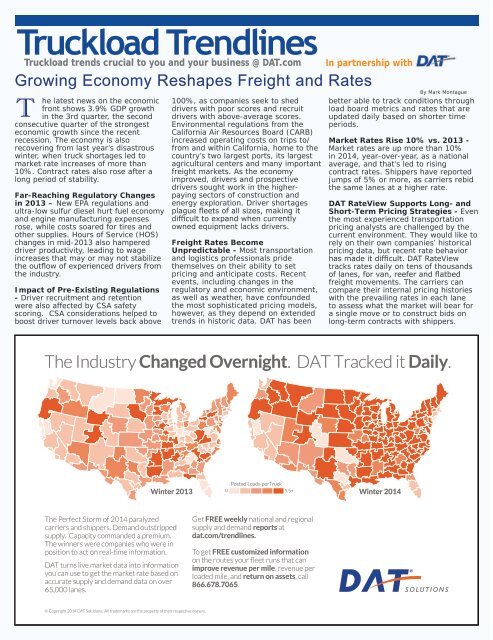Truckload Authority - Winter 2014/15
You also want an ePaper? Increase the reach of your titles
YUMPU automatically turns print PDFs into web optimized ePapers that Google loves.
<strong>Truckload</strong> trends crucial to you and your business @ DAT.com<br />
T<br />
he latest news on the economic<br />
front shows 3.9% GDP growth<br />
in the 3rd quarter, the second<br />
consecutive quarter of the strongest<br />
economic growth since the recent<br />
recession. The economy is also<br />
recovering from last year’s disastrous<br />
winter, when truck shortages led to<br />
market rate increases of more than<br />
10%. Contract rates also rose after a<br />
long period of stability.<br />
Far-Reaching Regulatory Changes<br />
in 2013 – New EPA regulations and<br />
ultra-low sulfur diesel hurt fuel economy<br />
and engine manufacturing expenses<br />
rose, while costs soared for tires and<br />
other supplies. Hours of Service (HOS)<br />
changes in mid-2013 also hampered<br />
driver productivity, leading to wage<br />
increases that may or may not stabilize<br />
the outflow of experienced drivers from<br />
the industry.<br />
Impact of Pre-Existing Regulations<br />
- Driver recruitment and retention<br />
were also affected by CSA safety<br />
scoring. CSA considerations helped to<br />
boost driver turnover levels back above<br />
100%, as companies seek to shed<br />
drivers with poor scores and recruit<br />
drivers with above-average scores.<br />
Environmental regulations from the<br />
California Air Resources Board (CARB)<br />
increased operating costs on trips to/<br />
from and within California, home to the<br />
country’s two largest ports, its largest<br />
agricultural centers and many important<br />
freight markets. As the economy<br />
improved, drivers and prospective<br />
drivers sought work in the higherpaying<br />
sectors of construction and<br />
energy exploration. Driver shortages<br />
plague fleets of all sizes, making it<br />
difficult to expand when currently<br />
owned equipment lacks drivers.<br />
Freight Rates Become<br />
Unpredictable - Most transportation<br />
and logistics professionals pride<br />
themselves on their ability to set<br />
pricing and anticipate costs. Recent<br />
events, including changes in the<br />
regulatory and economic environment,<br />
as well as weather, have confounded<br />
the most sophisticated pricing models,<br />
however, as they depend on extended<br />
trends in historic data. DAT has been<br />
In partnership with<br />
Growing Economy Reshapes Freight and Rates<br />
By Mark Montague<br />
better able to track conditions through<br />
load board metrics and rates that are<br />
updated daily based on shorter time<br />
periods.<br />
Market Rates Rise 10% vs. 2013 -<br />
Market rates are up more than 10%<br />
in <strong>2014</strong>, year-over-year, as a national<br />
average, and that’s led to rising<br />
contract rates. Shippers have reported<br />
jumps of 5% or more, as carriers rebid<br />
the same lanes at a higher rate.<br />
DAT RateView Supports Long- and<br />
Short-Term Pricing Strategies - Even<br />
the most experienced transportation<br />
pricing analysts are challenged by the<br />
current environment. They would like to<br />
rely on their own companies’ historical<br />
pricing data, but recent rate behavior<br />
has made it difficult. DAT RateView<br />
tracks rates daily on tens of thousands<br />
of lanes, for van, reefer and flatbed<br />
freight movements. The carriers can<br />
compare their internal pricing histories<br />
with the prevailing rates in each lane<br />
to assess what the market will bear for<br />
a single move or to construct bids on<br />
long-term contracts with shippers.

















